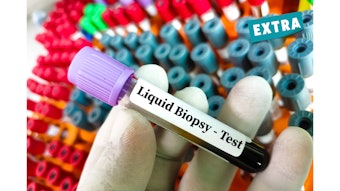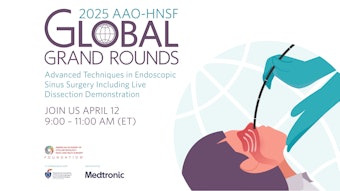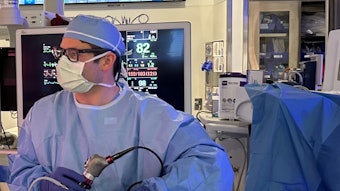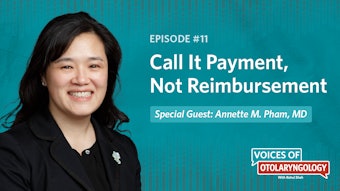Steroids and the Voice
Corticosteroids can provide meaningful benefits for treating voice disorders, but usage should be limited and reserved for specific indications.
Patrick O. McGarey, Jr, MD, and Anne F. Hseu, MD, on behalf of the Voice Committee

Before treating a patient for dysphonia, establishing a correct diagnosis is essential. The AAO-HNSF Clinical Practice Guideline for Hoarseness states that clinicians should not prescribe corticosteroids before performing laryngoscopy to evaluate the larynx.2
However, several causes of dysphonia may be treated with corticosteroids. Vocal fold scar/sulcus is a common cause of dysphonia that can be challenging to treat. Prior studies have shown improvements in patient-reported voice, clinician perceptual voice exam, and stroboscopy after subepithelial injection of dexamethasone.3 A more recent follow-up study by Kruse et al. (2023) demonstrated that a single injection is likely non-inferior to a series of three subepithelial injections of dexamethasone.4 A study by another laryngology practice suggested that about 50% of patients with vocal fold scar/sulcus will have a sustained improvement in voice after subepithelial corticosteroid injection.5
Intralesional corticosteroid injection may also benefit the treatment of benign phonotraumatic vocal fold lesions, specifically vocal fold polyps and vocal fold nodules. A study by Hsu et al. (2009) showed a 59% vocal fold polyp resolution rate at three months (without voice therapy) after polyp treatment with subepithelial injection of dexamethasone.6 Although vocal fold nodules are typically treated with voice therapy, larger nodules may benefit from corticosteroid injection. Wang et al. (2014) showed that in patients with vocal fold nodules treated with corticosteroid injection, there was greater reduction in lesion size at one month compared with voice therapy.7
In addition, vocal fold granulomas are associated with dysphonia, globus sensation, cough, and throat clearing. Intralesional and inhaled corticosteroids can be effective treatments with peer-reviewed evidence to support their use, although no randomized studies have been performed.8,9
Acute vocal fold edema commonly occurs in the setting of upper respiratory tract infections, allergies, or voice overuse. Although edema often resolves with voice rest, oral corticosteroids are frequently considered for performers with imminent vocal demands. In such cases, steroids can improve vocal function, allowing professionals to fulfill scheduled performances.10,11
When administered systemically, corticosteroids carry potential adverse effects, including mood disturbances, insomnia, and hyperglycemia. Prolonged or repeated use may also result in systemic complications such as immunosuppression, adrenal suppression, and osteoporosis.12
Clinicians must carefully evaluate the etiology of dysphonia, as laryngeal examination is essential for guiding treatment decisions. Corticosteroids should not be relied upon in cases where they fail to address underlying behavioral or structural causes of dysphonia, particularly when more effective long-term treatments such as voice therapy are indicated.
When used judiciously, corticosteroids can provide meaningful benefits. However, their use should be limited to short courses and reserved for specific indications. Engaging in shared decision-making and reviewing alternative treatments ensures appropriate steroid use while minimizing risks. Also, persistent dysphonia after treatment warrants repeat laryngoscopy to reassess the underlying cause.
References
- Furst DE, Saag KG. "Overview of the Pharmacologic Use of Glucocorticoids." In UpToDate, edited by Robert F. Connor. Waltham, MA: Wolters Kluwer, 2025. Accessed February 14, 2025.
- Stachler RJ, Francis D, Schwartz S, Rosenfeld RM, Cunnigham CR, Klein MS, Krouse HJ, et al. Clinical Practice Guideline: Hoarseness (Dysphonia) (Update). Otolaryngology–Head and Neck Surgery 158, no. S1 (March 2018): S1-S42.
- Young WG, Hoffman MR, Hennessy BN, Dailey SH, Thibeault SL. Voice Outcomes Following a Single Office-Based Steroid Injection for Vocal Fold Scar. Otolaryngology–Head and Neck Surgery 155, no. 5 (November 2016): 820-828.
- Kruse CM, Hoffman MR, Hennessy BN, Dailey SH, Thibeault SL. Voice Outcomes Following Serial Office-Based Steroid Injections and Voice Therapy for Vocal Fold Scar. Journal of Voice (April 2023). https://doi.org/10.1016/j.jvoice.2023.03.013.
- Axiotakis Jr L, Enver N, Kennedy EL, Franco Jr RA Duration of Clinical Response After In-Office Steroid Injection for Vocal Fold Scar. Laryngoscope 133, no. 1 (January 2023): 171-177.
- Hsu YB, Lan MC, Chang SY. Percutaneous Corticosteroid Injection for Vocal Fold Polyp. Archives of Otolaryngology–Head & Neck Surgery 135, no. 8 (August 2009): 776-780.
- Wang CT, Liao LJ, Lai MS, Cheng PW. Comparison of Benign Lesion Regression Following Vocal Fold Steroid Injection and Vocal Hygiene Education. Laryngoscope 124, no. 2 (February 2014): 510-515.
- Hillel AT, Lin LM, Samlan R, Murry T, Sulica L. Inhaled Triamcinolone with Proton Pump Inhibitor for Treatment of Vocal Process Granulomas: A Series of 67 Granulomas. Annals of Otology, Rhinology & Laryngology 119, no. 5 (2010): 325-330.
- Wang CT, Lai MS, Cheng PW. Long-term Surveillance Following Intralesional Steroid Injection for Benign Vocal Fold Lesions. JAMA Otolaryngology–Head & Neck Surgery 143, no. 6 (June 2017): 589-594.
- Estes MC, Chadwick K, Sadoughi B, Andreadis K, Sussman S, Sulica L. Performers' Perceptions of Vocal Function During Oral Steroid Treatment of Vocal Fold Edema. Laryngoscope 132, no. 12 (December 2022): 2434-2441.
- Estes MC, Chadwick K, Sadoughi B, Andreadis K, Sussman S, Sulica L. Prospective Evaluation of Safety of Singing on Steroids: Testing the Truth of Received Wisdom. Laryngoscope 131, no. 10 (October 2021): 2298-2304.
- Bock JM. Medications and Vocal Function. Otolaryngologic Clinics of North America 52, no. 4 (August 2019): 693-702.


















